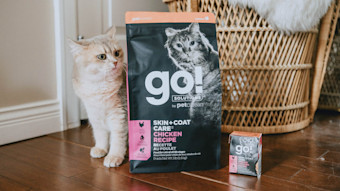July 29, 2025
How Much Wet and Dry Food to Feed a Cat

Feeding our cats is anything but an exact science. Whether you’re a first-time cat owner, or you’ve had one (or a few) for a while now, the question of “How much should I feed my cat?” can be a confusing one to answer.
With all the different considerations of things like weight, activity level, age, and environment, while adding in the difficulty of feeding a combination of wet and dry food - where do you start? Here are our top tips when it comes to figuring out how much to feed your cat.
Where to Start: Feeding Your Cat
A good place to start figuring out how much to feed your cat is to check your cat’s body condition. This can be done by using a body score chart so you can visibly and physically check and see if they are at a healthy weight, underweight or overweight. Additionally, you should weigh your cat so you can track it if their weight changes.
If you feed your cat primarily dry cat food, check the package for the daily feeding guidelines for his or her weight, age, and activity level. If you wish to feed your cat a mix of dry and wet food, then you will need to take all of those calories into consideration.
Remember that wet food is not as calorically dense as kibble simply because of the moisture levels.
You can find the feeding guidelines on your cat's food package, which will help you with the suggested daily amounts. Once you have found the daily recommended quantities for your cat for each type of food, it's simple math to determine how much each to feed.
Combination Feeding: Cat Feeding Guide Wet and Dry
Let’s say you have a 12 lb adult reasonably active cat. You want to feed her a combination of the Go! Carnivore Grain-Free Chicken, Turkey + Duck dry food and Go! Carnivore Grain-Free Chicken, Turkey + Duck Pâté.
If you want to feed 50% kibble, 50% wet, use the feeding guidelines for each, and feed half as much of each daily. In this example, you would feed about a ½ cup dry, and about 1 carton of wet per day.
If you want to feed 75% kibble, 25% wet, use the feeding guidelines for each and calculate how much 75% would be for feeding dry, and 25% of the feeding guidelines for the wet food. In this example, you would feed about a ¾ cup dry, and about .5 cartons of wet per day.
Adjust these amounts over time to achieve an ideal body weight. In addition, we recommend weighing your pet’s food for better accuracy.
Treats and toppers can add extra pounds to your cat if you’re not careful, so these should never be more than 10% of your cat’s daily caloric intake.

In Conclusion
Paying attention to the feeding guidelines will give you a good idea of where to start! Once you see how those amounts affect the body condition of your cat, you can adjust up or down from there.
Ensuring your cat has the proper amount of nutritional intake each day will be an ongoing balancing act. Just like people, their weight and body condition will fluctuate with activity level, climate, and age, so you need to be vigilant and keep a close eye on them to maintain a healthy weight.



